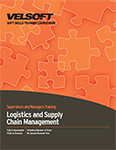Course outline for
Logistics and Supply Chain Management
Logistics and Supply Chain Management Course Outline

How to Use This Guide
Session One: Course Overview
Session Two: Getting Started
Defining the Terms
Regulations and Resources
Session Three: The Evolution of the Supply Chain
Vertical Integration Model
Virtual Integration Model
What’s Next?
Session Four: The Basic Supply Chain Structure
The Links in the Supply Chain
Making Connections
Participants in the Supply Chain
Designing Your Supply Chain
The Bullwhip Effect
Session Five: Supply Chain Drivers
Driving Success
Choosing the Right Transportation Methods
Making Connections
Session Six: Aligning Your Supply Chain with Business Strategy
Identifying Your Market
Making Connections
Looking at Your Role
Analyzing the Data
Taking the Next Steps
Making Connections
Session Seven: Managing Supply Chain Risks
Session Eight: Tracking and Evaluating Supply Chain Data
Ratios and Formulas
What is Benchmarking?
The SCOR Model
The Balanced Scorecard
Supply Chain Management Dashboards
Making Connections
Session Nine: Troubleshooting Supply Chain Problems
Signs of Trouble in Your Supply Chain
Supply Chain Best Practices
Session Ten: Sharing Supply Chain Activities
Outsourcing, Insourcing, Offshoring, and Reshoring
Third- and Fourth-Party Logistic Providers
Building Partnerships within Your Supply Chain
Session Eleven: Sustainable Supply Chain Strategies
What is Sustainability?
Reducing the Impact on the Environment
Session Twelve: Applying Lean Techniques to the Supply Chain
Lean 101
Applying Lean to the Supply Chain
Session Thirteen: The Future of Supply Chain Management
Top Trends
Making Connections
Recommended Reading List
Post-Course Assessment
Pre- and Post-Assessment Answer Keys
Personal Action Plan
Download this course as a demo
Complete the form below and we'll email you an evaluation copy of this course:
Video
More Course Outlines in this Series
- Budgets and Managing Money
- Becoming Management Material
- Coaching and Mentoring
- Conference and Event Management
- Delegation: The Art Of Delegating Effectively
- Effective Planning and Scheduling
- Giving Effective Feedback
- Human Resources Training: HR for the Non-HR Manager
- Intermediate Project Management
- Inventory Management: The Nuts and Bolts
- Leadership Skills for Supervisors
- Managing Difficult Conversations
- Marketing and Sales
- Meeting Management: The Art of Making Meetings Work
- Motivation Training: Motivating Your Workforce
- Negotiating for Results
- Project Management Fundamentals
- Project Management Training: Understanding Project Management
- Risk Management
- Team Building: Developing High Performance Teams
- The ABCs of Supervising Others
- The Professional Supervisor
- Tough Topics: Talking to Employees about Personal Hygiene
- Managing the Virtual Workplace
- Logistics and Supply Chain Management
- Conversational Leadership
- Workplace Health and Safety: The Supervisor's Role and Responsibilities
- Women and Leadership: Owning Your Strengths and Skills
- Managing Across Cultures
- Becoming a Progressive Employer
- From Boss to Leader
- Dealing With Difficult People
- Design Thinking: An Introduction
- Vendor Management Essentials
- How to Become a Leader with Integrity
- Progressive Discipline
- Progressive Discipline
- Corrective Action
- Project Management Principles and Performance Domains
- Advanced Project Management
